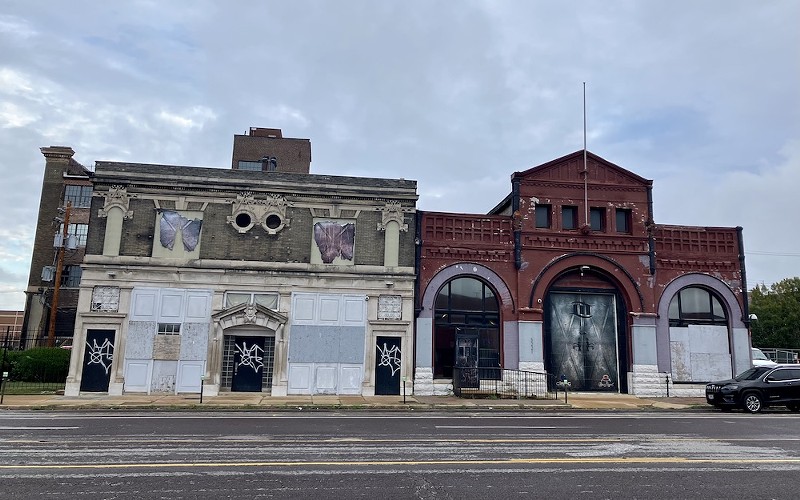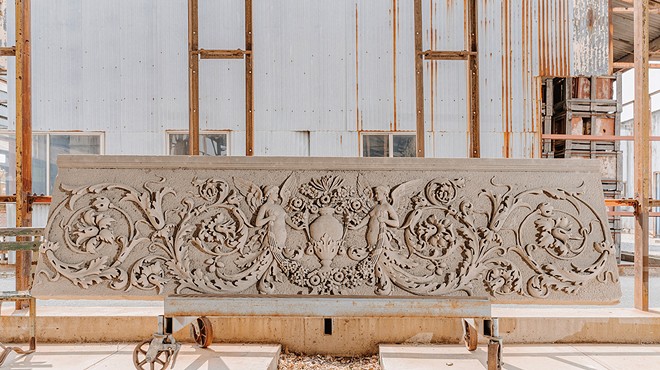
SARAH FENSKE
Saint Louis University has applied for demolition permits for 3223 Olive Street, left, and 3221 Olive.
Saint Louis University apparently didn't get the memo. The Jesuit school that's long been an anchor in Midtown plans to raze two of the few remaining buildings left from the neighborhood. It's seeking a demolition permit for 3221 and 3223 Olive Street.
The Mill Creek Valley connection is one big reason preservationists plan to protest the demolition on Wednesday.
"We're starting to build monuments to the neighborhood, to finally memorialize it, and in the same breath, they're wanting to tear these buildings down," says Bryan Hadley, one of the preservationists behind the protest.

Screengrab via YouTube
Author Vivian Gibson.
"They missed the footprint by a hair, but it really is Mill Creek," she says. "It's absolutely within the footprint of where Black people lived in St. Louis in the first half of this century, which went all the way over to Franklin. I would say, 'Why not renovate it for affordable housing for people?' Not necessarily students, either."
In a statement, Saint Louis University said, "SLU is committed to ensuring the long-term vitality and vibrancy of the campus and the surrounding community. In an effort to continue to improve the area around SLU’s campus, the University recently acquired these two structures, which had been vacant and boarded up for many years.
"It is in no one’s interest for the buildings to continue to deteriorate indefinitely. While SLU applied for a demolition permit, the University is also seeking to engage parties interested in acquiring and redeveloping the properties."
Hadley says the buildings in question are linked to restaurateur Tony Faust, best known for the Tony Faust Oyster House, which was considered the city's top restaurants before it closed in 1916. According to a post written by Erica Threnn of Found St. Louis, 3223 Olive is the sole building remaining from the Faust empire.
"In 1890, Faust opened up a branch of his market to serve the folks of this neighborhood," Threnn reports. "After the market closed, this building had various businesses come and go over the years. Many will remember it as the nightclub Dante's." (Threnn said that she drew on the work on St. Louis Patina blogger Chris Naffziger, Andrew Weil of the Landmarks Association of St. Louis and old newspaper clips in compiling her account.)
Both Threnn and Hadley are spreading the word about the protest Wednesday, planned at the site from 6:30 to 7:45 p.m. (And Gibson, for one, says she'll be there.)
Barring public pressure, Hadley says Saint Louis University could have a relatively simple path to demolition. The site is not in a preservation review district and does not have to go before the city's Preservation Board, which has taken a hard line on some recent proposals.
Even so, he's hopeful SLU could change course. He notes that the university does not even have a plan for the site and that its request is "merely routine hedge pruning and housekeeping for SLU," in the words of the preservationists' press release. That makes it even more galling than the St. Louis Symphony Orchestra's recent razing of the 19th-century Culver House, which was pitched as necessary for Powell Hall's expansion (and which preservationists also objected to).
"For me personally, this is not just about these buildings, but all of the historic buildings of St. Louis," Hadley says. "It's really just nauseating that structures like these aren't going to go before the review board. The public needs a chance to make the case for their preservation."
Hoping to do just that is Gibson, who says she's been frustrated by the way Saint Louis University has refused to give even lip service to the Mill Creek neighborhood, despite the fact that it now owns one-third of the urban renewal footprint. When her committee approached the university about a mural to commemorate the site, they were told it had to be temporary — and then they were offered a spot at a dog park.
"They said it was a sculpture park," she said, referring to the university's combination dog/sculpture park at Lindell and Grand. "It was so insulting, we said, 'Thank you, but no thank you.'" She adds, "The people we talked to initially [at SLU] had never even heard of Mill Creek. The deaf ear is just insulting."
Hadley also notes the irony of SLU seeking its demolition permit even as a new show at the Pulitzer Arts Foundation showcases the art of St. Louis' demolished buildings.
"I've been here for 10 years, and I've watched time and again as this has played out," he says. "There are so many treasures here that are taken for granted."
Editor's note: This story was updated to include a statement from Saint Louis University and also more information about the research into the building.
Subscribe to Riverfront Times newsletters.
Follow us: Apple News | Google News | NewsBreak | Reddit | Instagram | Facebook | Twitter | Or sign up for our RSS Feed









